About five years ago, when I needed to make room for another boat in the garage, I moved one of my Greenland kayaks out and tucked it under the eaves on the north side of my house. It wouldn’t be as well protected there as it had been in the garage, but it would be out of the sun and only occasionally subject to rain. Perched with its bow resting on a downspout and the aft deck on a bracket clamped to the power meter’s conduit, the kayak’s cockpit crossed the windows of my study and its stern hung over the back door. While it was never out of view, it was soon out of mind.
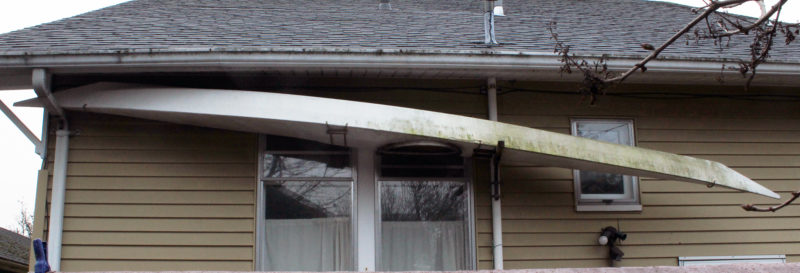 Photographs by the author
Photographs by the authorProtected by the eaves above, the kayak hung in plain sight and yet sadly out of mind. Over time the neglect began to show.
While I “saw” the kayak several times a day, I’ve been blindered by routine and paid no more attention to it than I did the gutter above it. One dim gray afternoon this winter, a patch of color caught my eye and I finally took notice of the kayak. Half of its starboard side was no longer white but a mottled olive green where it had been hit by the rain. In that moment, I was struck by an ache for how forlorn the kayak looked. In The Wind in the Willows, when Mole first saw Rat’s boat, his “whole heart went out to it at once,” but while Mole had been moved by a boat’s beauty, I felt sadness for the kayak’s sorry state. Perhaps there is something inherent in a boat, no matter its state, that can evoke feelings normally reserved for living beings.
Beneath the kayak, in the meager shelter of the same eave, lie a snow shovel, a spade, leaf and garden rakes, and a lawn edger. They are all showing the effects of exposure to the weather—rust, peeling varnish, wood turned leaden gray—but “forlorn” has never come to mind when I see them. While I can let my yard and garden tools deteriorate to the point where I’d discard them and buy new ones, I couldn’t let that happen to the kayak. Even though I had no use for the kayak, as I did for the tools languishing on the walkway below it, to let all that work done with care by hand come to an end through neglect was unconscionable.
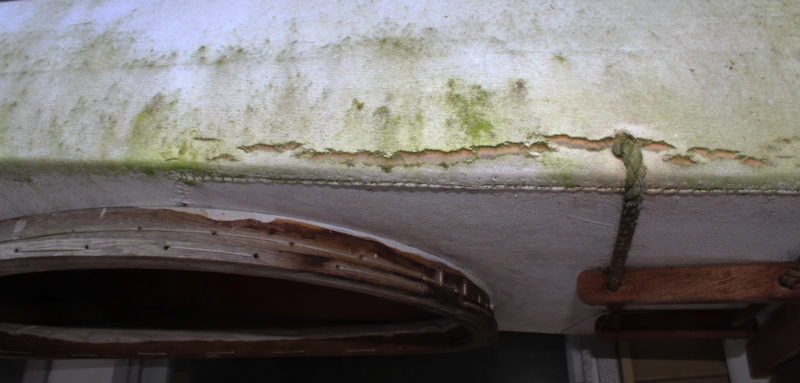
Where the butyrate-dope covered canvas skin was exposed to the rain, it had torn itself apart.
I set up a ladder and climbed up to take a closer look at the kayak. Along the sheer the canvas skin had pulled apart in a jagged 18″ tear, revealing the still-blond spruce gunwale beneath it. When I peeked into the hull through the cockpit opening, I expected to find a bird’s nest but saw instead a paper-wasp nest the size of a cantelope hanging from the keelson in the stern. I counted that as lucky—the wasps hadn’t made a mess of the kayak as nesting birds surely would have.
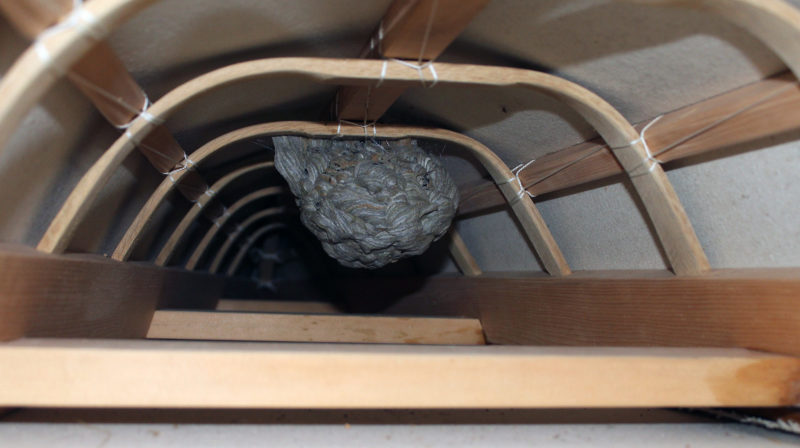
If I had been more observant, I would have seen wasps flying in and out of the kayak cockpit. Their nests are only used once; I don’t know how many years this one has been in the kayak. Even if this one is recent, it’s empty during the winter and I’ll be able to remove it.
The frame was in very good shape, and the warm scents of oak and spruce filled the hull’s interior even in the cold winter air. The mortise-and-tenon joints between the deckbeams and the gunwales were as snug as they had been when I’d made them, and even the pencil marks I had made on the gunwale at those joints were still dark and sharp.
The kayak’s canvas skin and braided seine-twine lashings were materials I had stopped using decades ago when I switched to nylon and artificial sinew. Seeing the seine twine, I found I couldn’t remember building or paddling the kayak. I went to my study and checked some 30-year-old photos of kayaks I’d built, but the one under the eave didn’t appear in any of them. All of my other boats have histories that deepen my connections to them, but the absence of that connection didn’t diminish the feeling I had that this kayak deserved better.
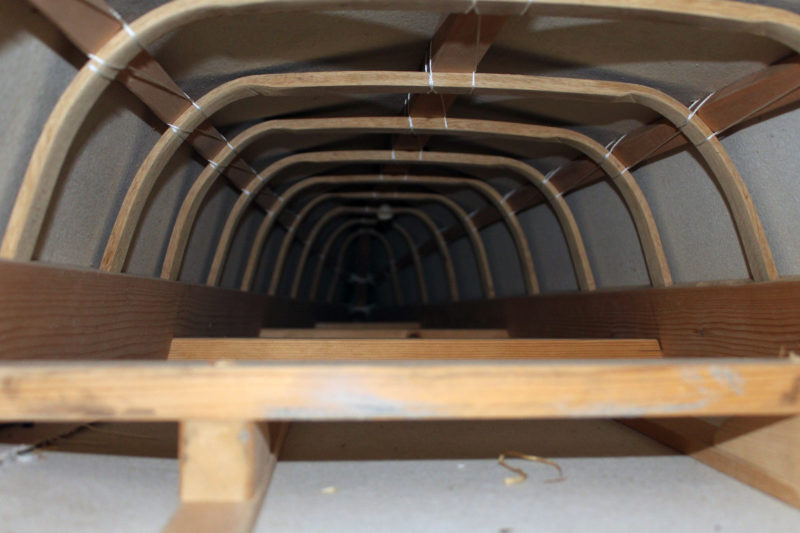
The interior of the kayak was in good shape. Indeed, the framework of oak and spruce frame and the braided seine-twine lashings looked almost as good as new. The deck beam in the foreground is the foot brace and it shows little wear, an indication that I hadn’t paddled the kayak often.
I’d once had the same feeling for a boat that wasn’t even mine. A few years ago, a handsome 14′ cedar-on-oak lapstrake rowing skiff sat strapped to a trailer parked on the street a block from my home. It had no cover, and through the fall and winter rains it often filled with so much water that I feared the weight would tear the hull apart. That boat certainly deserved better. After a spell of rain, I’d walk to the boat with a 10′ length of garden hose and set it up as a siphon to empty it. The skiff survived the winter and disappeared in the spring. I never knew who built it or who rowed it.
While people may feel affection for inanimate objects—cabins, cars, furniture, works of art—what designers and builders put into boats make them unique. On the water, a boat gives back what it is given on land. And for boaters, being on the water requires trust of a kind that isn’t required of anything on land; it is easier, perhaps, to put that trust in something we feel is more than a senseless object.
The kayak will come down from the eaves and get the care it deserves. New Year’s Day is a celebration of what lies ahead, and my kayak has served as a reminder for me to see without blinders and to give attention to those easily overlooked, forgotten, and left behind.![]()



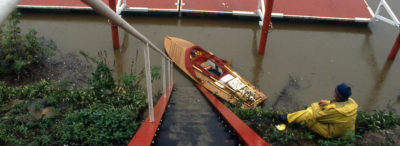
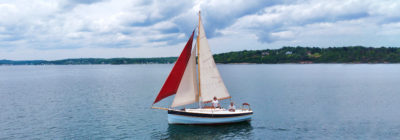

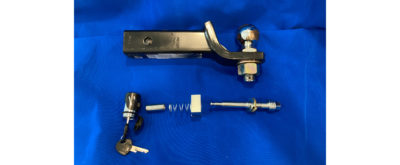
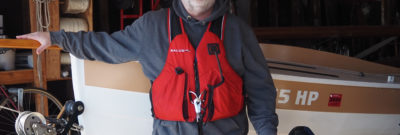



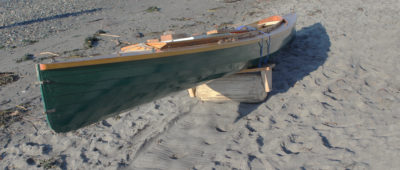
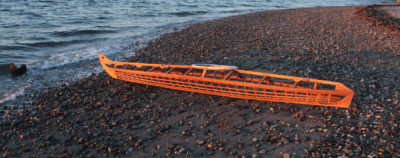
An eloquent, thoughtful essay. And one that I’m sure touches a lot of readers of this journal because we have a tendency to build or acquire more boats than we can use—or provide proper shelter for.
Here in the Pacific Northwest we have kind of a tradition of half-burying small wooden boats that have outlived their usefulness in the ground, where they may acquire a second life as planters. Or if we have no horticultural ambitions, we simply allow the relentless nag of Northwest rain to slowly return the hulls to the earth. Either way seems like a graceful and not unsightly end for a used-up boat.
Larry,
I once saved a boat from being a planter. It was a kicker boat/skiff, that were rented at the Camano Island resorts. I salvaged the 7/8×8 inch planking and repurposed it into my electric launch. It was a good feeling to continue the life of the old boat. ;o)
…and then there are the “almost finished” boats likewise deserving some greater attention.
Another kind of boat often seen residing forlornly in back yards and driveways is the unfinished ferro cement project (though usually not a small boat). Bolger commented one time that when budgeting for an FC boat, you should add in the cost of demolition.
P.S. One designer (maybe the only one) of small FC boats is Jay Benford, who designed concrete boats as small as 17 feet.
Below my parents’ house, which overlooked the Aire Valley between between Bingley and Keighley in Yorkshire, ran the Leeds-Liverpool Canal, long abandoned by commercial traffic but still open to pleasure craft. As a boy I often walked home from school along the towpath. I would see all sorts of small pleasure boats moored and in little boat yards, many well maintained, but some slowly melting into the mud and weeds. I always felt a sense of extreme sadness to see those little wooden craft rotting away. I think there is a sense of soul in a handcrafted boat, inherited maybe from those who built it, that a fiberglass boat however beautiful can never acquire.
Andrew,
Right!
I think, wow, at one point that boat was someone’s joy and they took pride in its completion.
I have given my unused boats away, hoping that the new owner would take care of them. I’m sure, that’s not always the case.
I’ve taken on as a retirement hobby picking up an old unwanted under
18-ft sailboat and restoring it. And then selling it for the cost
of the material I’ve had to put into it. It’s kept me busy in the spring,
and it’s a great feeling to see the boat rolling down the road to a new home.
PS They have to be under 18 ft to fit in my garage.
Whether boat, or bat, or bucket, something forlorn about the unused or abandoned. Often walking by a yard or vacant lot I get a tug in the gut for these orphaned things.